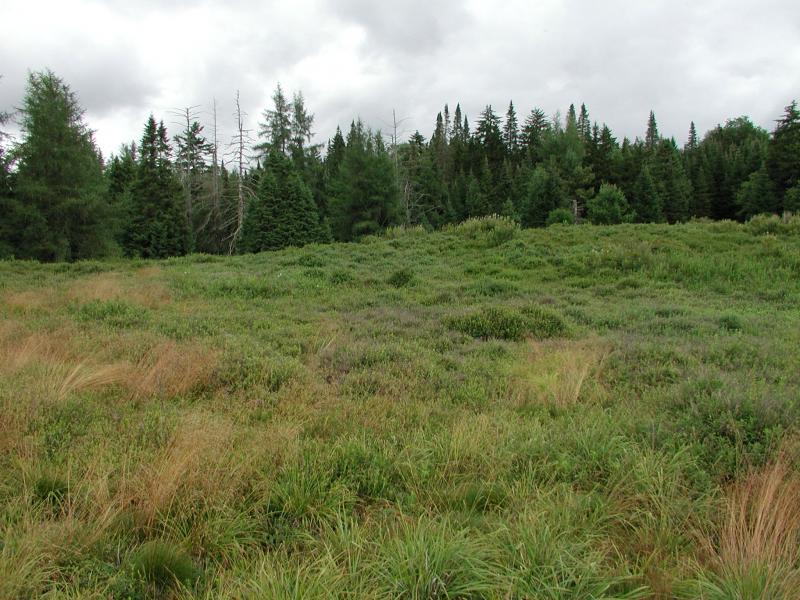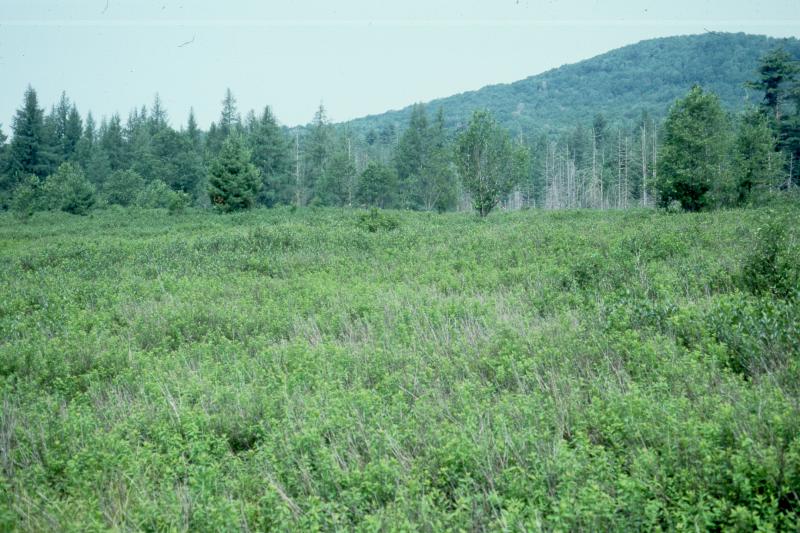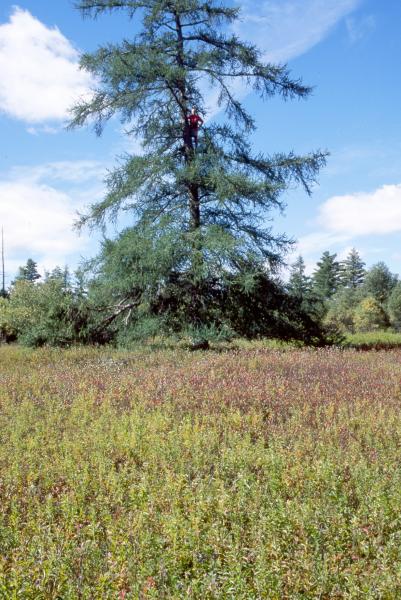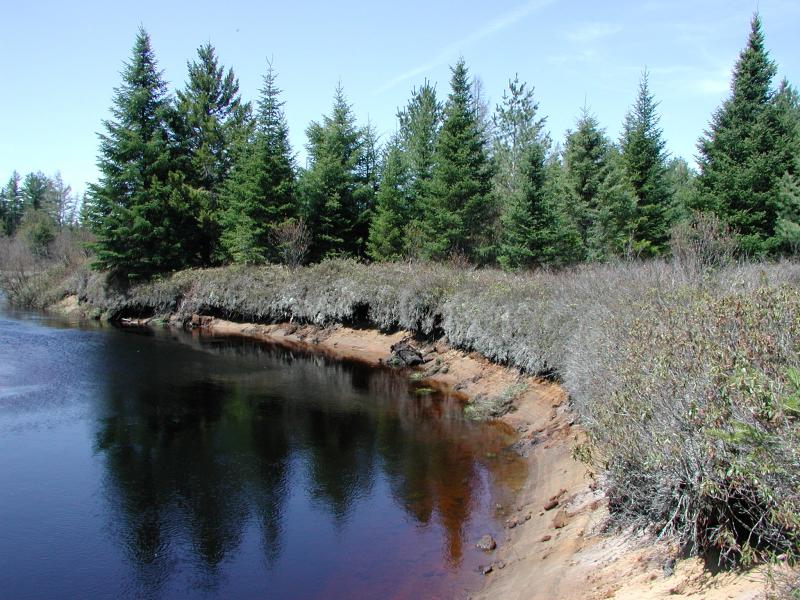Boreal Heath Barrens
- System
- Terrestrial
- Subsystem
- Barrens And Woodlands
- State Protection
- Not Listed
Not listed or protected by New York State.
- Federal Protection
- Not Listed
- State Conservation Status Rank
- S1
Critically Imperiled in New York - Especially vulnerable to disappearing from New York due to extreme rarity or other factors; typically 5 or fewer populations or locations in New York, very few individuals, very restricted range, very few remaining acres (or miles of stream), and/or very steep declines.
- Global Conservation Status Rank
- G3G4
Vulnerable globally, or Apparently Secure - At moderate risk of extinction, with relatively few populations or locations in the world, few individuals, and/or restricted range; or uncommon but not rare globally; may be rare in some parts of its range; possibly some cause for long-term concern due to declines or other factors. More information is needed to assign either G3 or G4.
Summary
Did you know?
The terms 'boreal', 'heath', and 'barrens' accurately describe this community: 'Boreal' describes the circumpolar forest region in the northern hemisphere that is generally dominated by conifer tree species; the boreal forest extends north to the treeless tundra and south to the mixed conifer/deciduous forests or temperate grasslands. 'Heath' refers to shrubs in the heath family (Ericaceae), also called ericaceous shrubs that are broad-leaved, often evergreen with leathery leaves and a compact growth form. 'Barrens' refers to a depauperate community with either a low canopy coverage or with stunted individuals of species which elsewhere reach considerable size; this term is applied to both savannas and woodlands.
State Ranking Justification
This is a relatively uncommon natural community with an estimated 15 to 30 extant occurrences statewide. A few documented occurrences have good viability and are protected on public land or private conservation land. This community has a limited statewide distribution (correlated to old lake deltas and outwash plains in the Adirondacks). Although there is one large occurrence documented, most are around 100 acres or less in size. Threats to this community include fire suppression, fragmenting development, recreational overuse, habitat alteration, and to a lesser extent invasive species.
Short-term Trends
The number and acreage of boreal heath barrens in New York have probably declined slightly in recent decades due to fire suppression, disturbance by off-road vehicles, and development.
Long-term Trends
The number and acreage of boreal heath barrens in New York have probably had substantial declines from historical numbers due to fire suppression, fragmentation, disturbance by off-road vehicles, and development. The area of the boreal heath barrens at one site (Oswegatchie Plains) is reportedly smaller than it was in the early 1900's.
Conservation and Management
Threats
As a fire-dependent natural community, the primary threat to boreal heath barrens is the suppression of fire. Other threats to this community include fragmenting development (e.g., residential, agricultural, plantations, roads, trails), recreational overuse (e.g., ATV use, hiking), and habitat alteration (e.g., logging). Although not currently considered a major threat, invasive species may become a problem at some sites in the future. Parts of some boreal heath barrens are used for Christmas tree farms and Scotch pine plantations.
Conservation Strategies and Management Practices
Develop and implement prescribed burn plans at appropriate sites. Reduce or minimize fragmenting features, such as residential and commercial development, roads, abandoned clearings, unnecessary trails, etc. Restrict mountain bikes and ATVs to designated trails and least sensitive areas, and prevent dumping of trash. Remove or control invasive species where appropriate.
Development and Mitigation Considerations
The soils are acidic, nutrient poor and often seasonally flooded. Any disruption of the hydrology or soil enrichment contamination (e.g., from septic leach fields and fertilized lawns) in or around the barrens may alter its community structure and function. The open structure of this community is often maintained by fire and can present a fire hazard to existing and proposed development. Unprotected structures located within or near this community are more susceptible to damage from fire.
Inventory Needs
Inventory all existing occurrences with records greater than ten years old. Continue searching for large sites in good condition (A- to AB-ranked). Survey the largest leads for this community (e.g., Rickerson Brook Headwaters - 2,200 acres, Cold Brook Flats - 750 acres, Rainier Pond Burn - 600 acres, and Moose River Plains - 375 acres). Need critical assessment of identity for several occurrences lacking heath-dominated association using statistical ordination techniques, in order to clearly separate boreal heath barrens from the successional blueberry heath community.
Research Needs
Determine the optimal fire regime for this community. This community needs to be compared to heath barrens in other states (e.g., Maine or Michigan) and in Canada to evaluate quality and composition in a regional context.
Rare Species
Range
New York State Distribution
The range of this community is probably limited to localized old lake deltas and outwash plains in the Western Adirondack Foothills and Central Adirondacks. It occurs primarily in Franklin, St. Lawrence, Lewis, Essex and Hamilton counties. The historical range is unknown, but is likely to have been restricted to this same area.
Global Distribution
This may be a regionally endemic community, or potentially widespread north of New York. Similar associations are reported from Maine, New Hampshire, Michigan and Canada. In New York, it is essentially restricted to the Adirondacks. Limited data are available outside of that area.
Best Places to See
- Raquette Boreal Wild Forest (St. Lawrence County)
- Moose River Plains Wild Forest (Hamilton County)
- Five Ponds Wilderness (St. Lawrence County)
- Independence River Wild Forest (Lewis County)
- Debar Mountain Wild Forest
Identification Comments
General Description
A dwarf shrubland or shrub-savanna dominated by heath or heath-like shrubs. Boreal heath barrens occur on nearly level outwash plains of the Adirondacks, in frost pockets lying in valleys. Soils are sandy, dry, and poor in nutrients. Boreal heath barrens are seasonally flooded because the soils have a discontinuous subsurface layer of podzolized soil (an ortstein), which impedes water drainage. Their habitat structure is often very variable with several potential patches including lichen-dominated areas, moss-dominated areas, herb-dominated areas, dwarf shrubland, tall shrubland and woodland.
Characters Most Useful for Identification
The dominant shrubs are blueberries (Vaccinium myrtilloides, V. angustifolium, V. pallidum), black chokeberry (Photinia melanocarpa), meadow-sweet (Spiraea alba var. latifolia), and mountain fly honeysuckle (Lonicera villosa). Other characteristic plants include ricegrasses (Oryzopsis asperifolia, O. pungens, O. canadensis), swamp dewberry (Rubus hispidus), Canada goldenrod (Solidago canadensis), flat-top goldenrod (Euthamia graminifolia), northern tree clubmoss (Dendrolycopodium dendroideum), running-pine (Diphasiastrum digitatum), lichens (Cladonia alpestris, C. pyxidata, Cladina rangiferina), and mosses (Pleurozium schreberi, Polytrichum commune, and Dicranum spp.). Trees may be scattered through the barrens, or confined to the edges of open shrublands. Characteristic trees are black spruce (Picea mariana), white pine (Pinus strobus), black cherry (Prunus serotina), and tamarack (Larix laricina).
Elevation Range
Known examples of this community have been found at elevations between 564 feet and 1,640 feet.
Best Time to See
These heath barrens are lovely in fall when leaves of the dominant shrubs turn deep shades of red, orange and purple.
Boreal Heath Barrens Images
Classification
International Vegetation Classification Associations
This New York natural community encompasses all or part of the concept of the following International Vegetation Classification (IVC) natural community associations. These are often described at finer resolution than New York's natural communities. The IVC is developed and maintained by NatureServe.
- (Lowbush Blueberry, Velvetleaf Huckleberry, Blue Ridge Blueberry) - Grey-green Reindeer Lichen Dwarf-shrubland (CEGL006426)
NatureServe Ecological Systems
This New York natural community falls into the following ecological system(s). Ecological systems are often described at a coarser resolution than New York's natural communities and tend to represent clusters of associations found in similar environments. The ecological systems project is developed and maintained by NatureServe.
- Acadian Sub-boreal Spruce Barrens (CES201.561)
Characteristic Species
-
Trees > 5m
- Picea mariana (black spruce)
- Pinus strobus (white pine)
- Populus tremuloides (trembling aspen, quaking aspen)
- Prunus serotina var. serotina (wild black cherry)
-
Shrubs 2 - 5m
- Amelanchier spp.
- Populus tremuloides (trembling aspen, quaking aspen)
- Prunus serotina var. serotina (wild black cherry)
- Viburnum nudum var. cassinoides (northern wild-raisin)
-
Shrubs < 2m
- Amelanchier spp.
- Aronia melanocarpa (black chokeberry)
- Rubus hispidus (swamp dewberry)
- Spiraea alba var. latifolia (broad-leaved meadow-sweet)
- Vaccinium angustifolium (common lowbush blueberry)
- Vaccinium myrtilloides (velvet-leaved blueberry)
-
Herbs
- Avenella flexuosa (common hair grass)
- Carex debilis var. rudgei (Rudge's sedge)
- Danthonia spicata (poverty grass)
- Dendrolycopodium dendroideum (prickly tree-clubmoss, northern tree-clubmoss)
- Diphasiastrum digitatum (southern ground-cedar)
- Doellingeria umbellata var. umbellata (tall flat-topped white-aster)
- Euthamia graminifolia (common flat-topped-goldenrod)
- Oryzopsis asperifolia (spreading white grass)
- Pteridium aquilinum ssp. latiusculum (eastern bracken fern)
- Rubus repens (dewdrop)
- Solidago canadensis var. canadensis (Canada goldenrod)
-
Nonvascular plants
- Cladina rangiferiina
- Cladonia alpestris
- Cladonia pyxidata
- Dicranum spp.
- Pleurozium schreberi
- Polytrichum commune
Similar Ecological Communities
- Successional blueberry heath
Can be distinguished by its relatively short-lived intermediate stage of succession from a cultural community (farmland, logged land or other intense disturbance) into more mature successional communities representing later seral states.
- Successional shrubland
This transitional community occurs on loamy soils (versus sands) at sites recovering from prior clearing or disturbance. It has 50% or more cover of shrubs.
Vegetation
Percent cover
This figure helps visualize the structure and "look" or "feel" of a typical Boreal Heath Barrens. Each bar represents the amount of "coverage" for all the species growing at that height. Because layers overlap (shrubs may grow under trees, for example), the shaded regions can add up to more than 100%.
Additional Resources
References
Bray, W.L. 1915. The development of the vegetation of New York State. New York State College of Forestry, Tech. Publ. No. 3, Syracuse, NY.
Bray, W.L. 1921. The history of forest development on an undrained sand plain in the Adirondacks. New York State College of Forestry at Syracuse University. Tech. Publ. 13, 21(2):1-47.
Curran, R.P. 1974. Vegetational development of the Plains of the Oswegatchie. M.S. Thesis, SUNY-ESF, Syracuse, NY. 186 pp.
Edinger, G. J., D. J. Evans, S. Gebauer, T. G. Howard, D. M. Hunt, and A. M. Olivero (editors). 2014. Ecological Communities of New York State. Second Edition. A revised and expanded edition of Carol Reschke’s Ecological Communities of New York State. New York Natural Heritage Program, New York State Department of Environmental Conservation, Albany, NY. https://www.nynhp.org/ecological-communities/
Edinger, Gregory J., D.J. Evans, Shane Gebauer, Timothy G. Howard, David M. Hunt, and Adele M. Olivero (editors). 2002. Ecological Communities of New York State. Second Edition. A revised and expanded edition of Carol Reschke's Ecological Communities of New York State. (Draft for review). New York Natural Heritage Program, New York State Department of Environmental Conservation. Albany, NY. 136 pp.
New York Natural Heritage Program. 2024. New York Natural Heritage Program Databases. Albany, NY.
Reschke, Carol. 1990. Ecological communities of New York State. New York Natural Heritage Program, New York State Department of Environmental Conservation. Latham, NY. 96 pp. plus xi.
About This Guide
This guide was authored by: Aissa Feldmann
Information for this guide was last updated on: December 14, 2023
Please cite this page as:
New York Natural Heritage Program. 2024.
Online Conservation Guide for
Boreal heath barrens.
Available from: https://guides.nynhp.org/boreal-heath-barrens/.
Accessed July 27, 2024.




